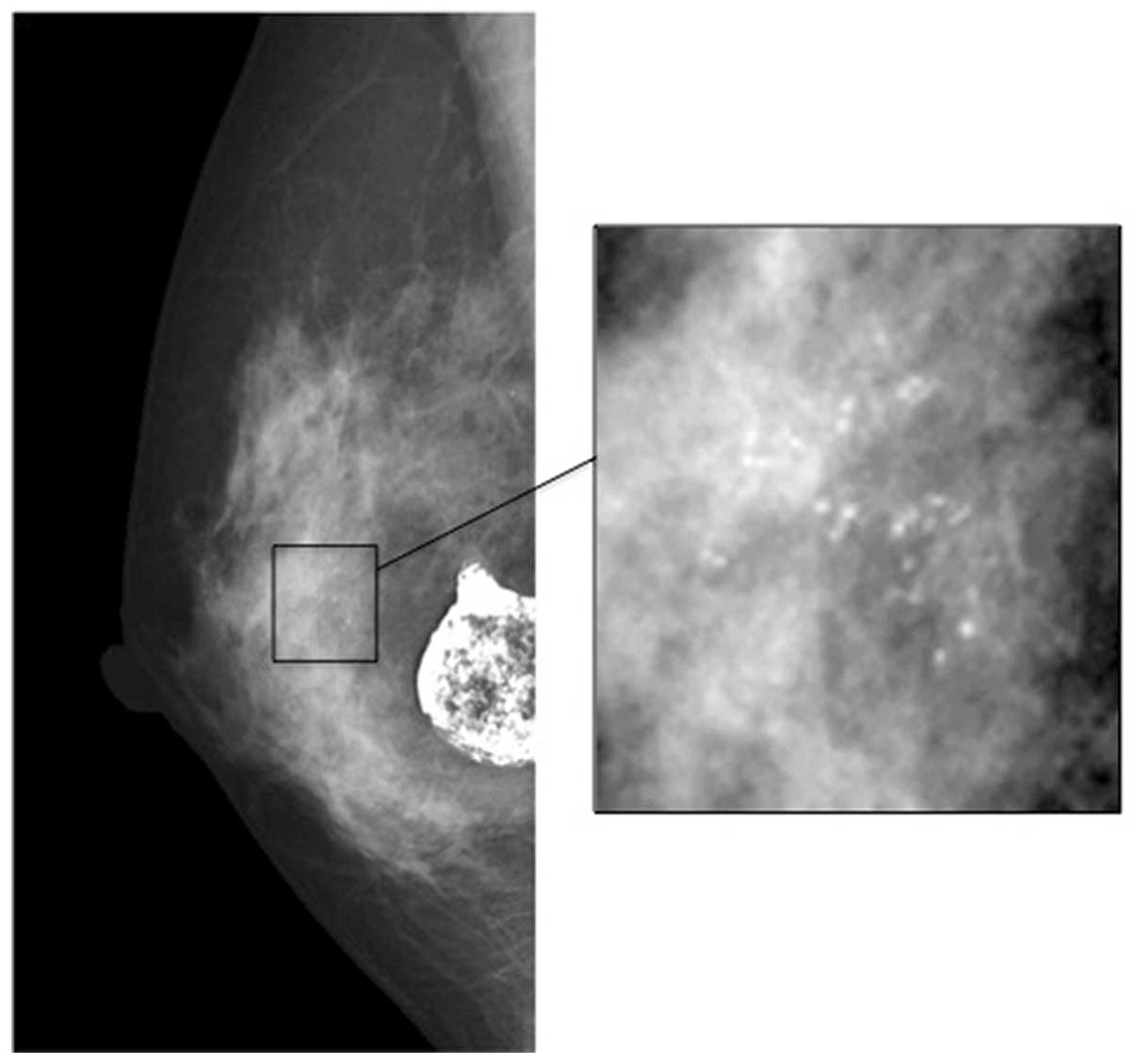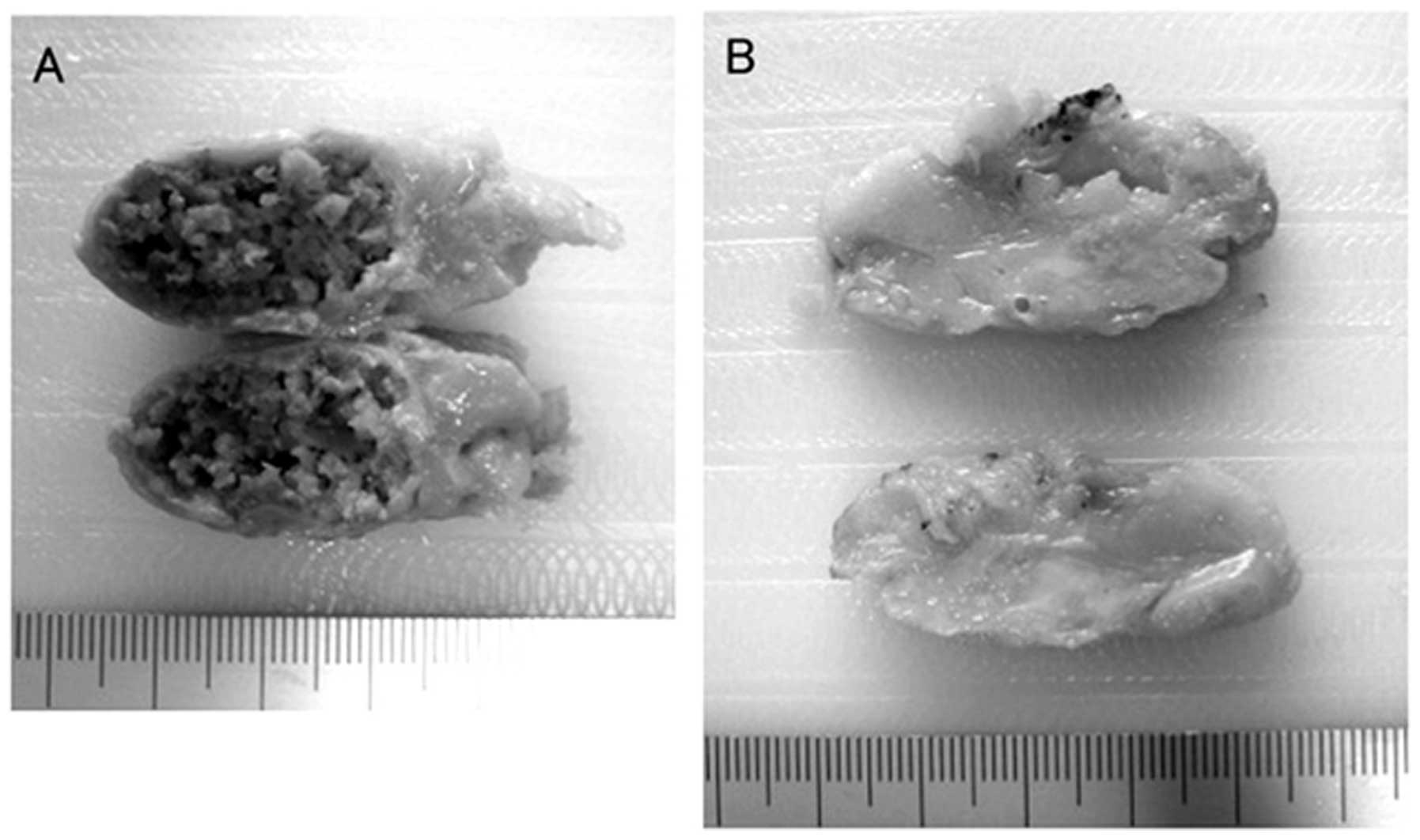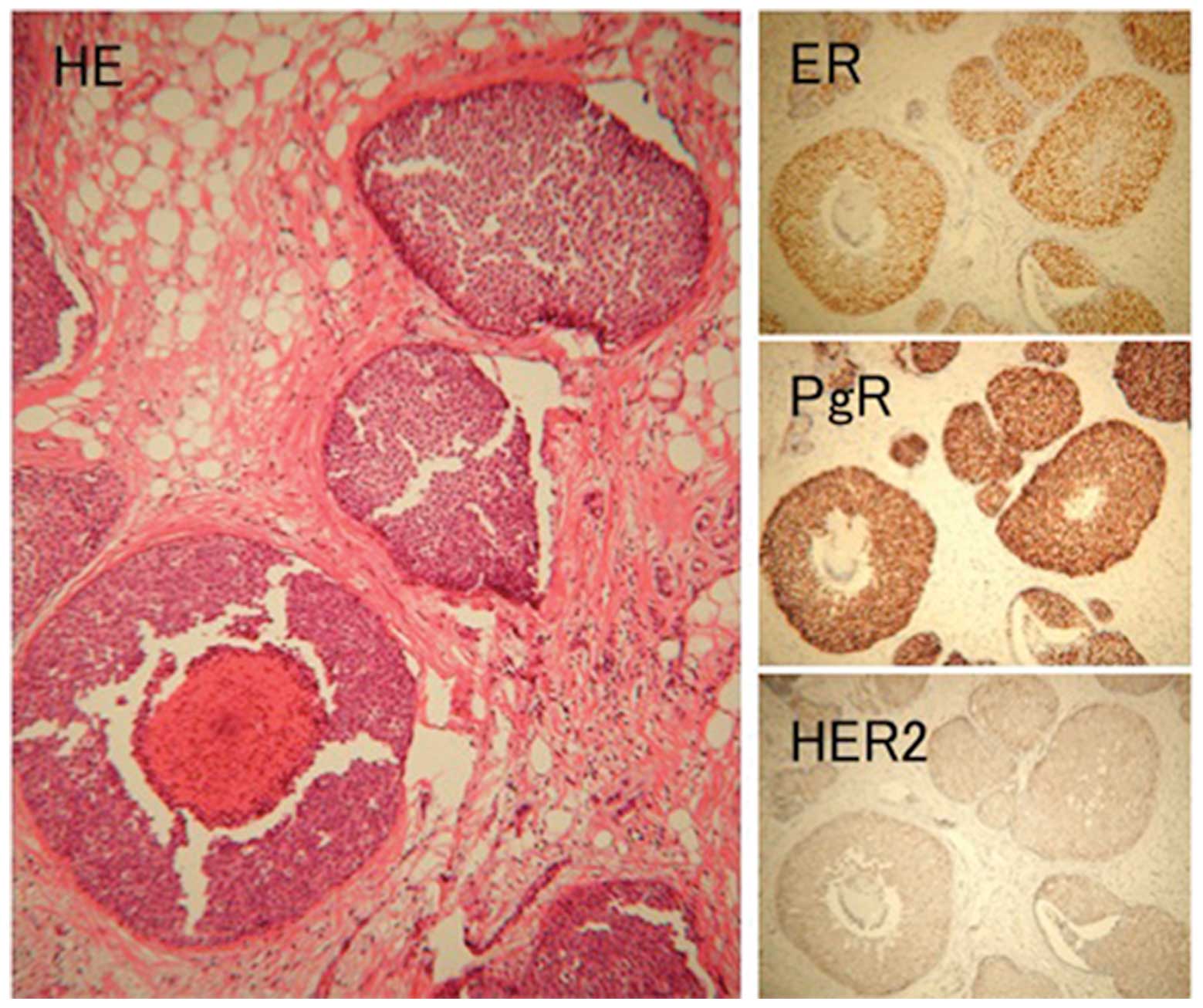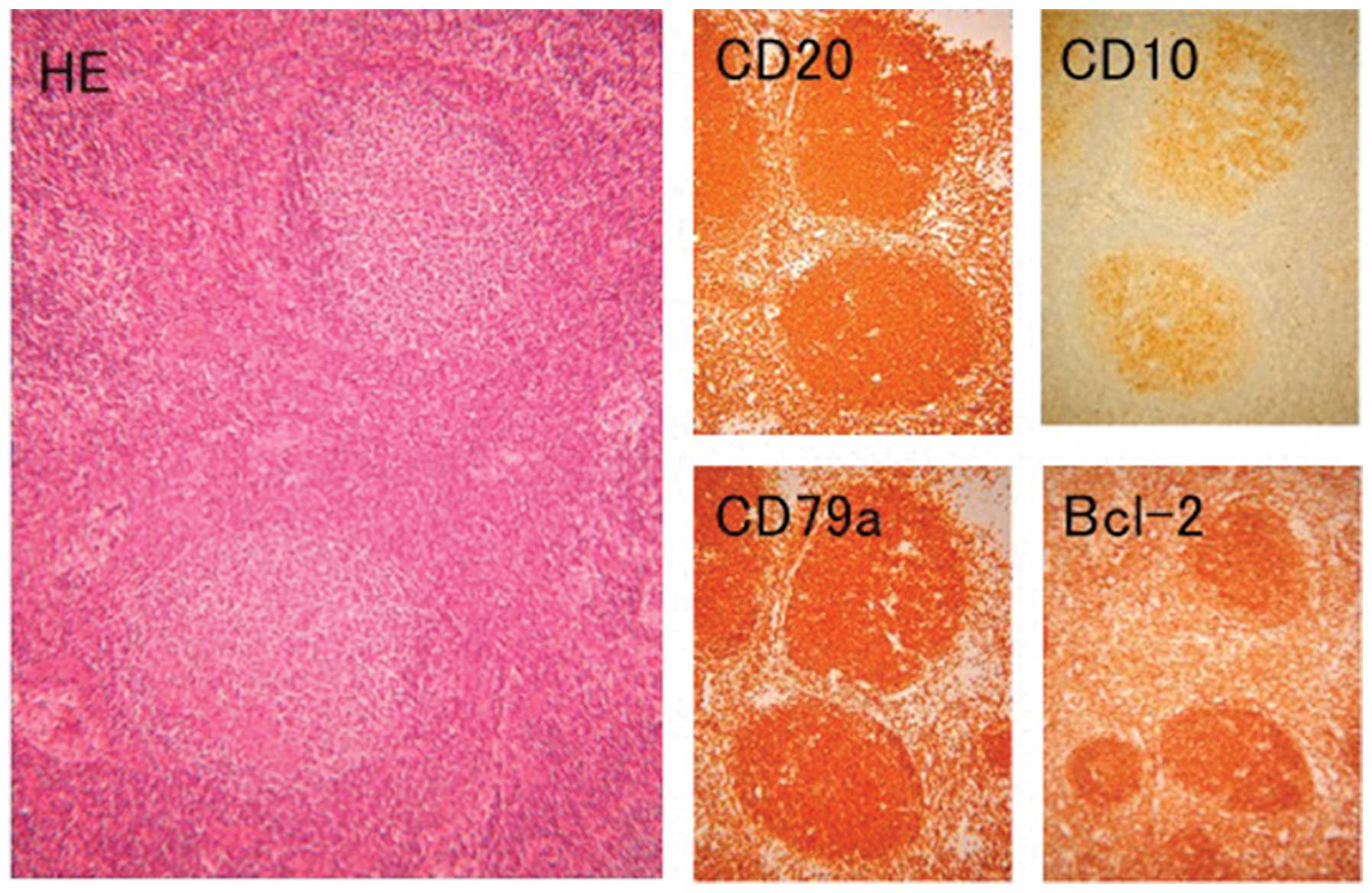A rare case of non‑invasive ductal carcinoma of the breast coexisting with follicular lymphoma: A case report with a review of the literature
- Authors:
- Published online on: February 14, 2014 https://doi.org/10.3892/ol.2014.1885
- Pages: 1001-1006
Abstract
Introduction
The incidence of breast cancer (BC) is extremely high, and malignant lymphoma (ML) is a common malignant disease. It is also well known that BC is the most frequent secondary malignancy following treatment for Hodgkin’s lymphoma (HL), particularly in young females who receive radiotherapy for early-stage HL (1–3). By contrast, the incidence of ML, including HL and non-HL (NHL) as second malignancies following breast conserving surgery and radiotherapy (RT) for BC, is rare (4,5).
Follicular lymphoma (FL) is classified as an NHL, amongst which FL is categorized as a low-grade ML and grows slowly. The incidence of FL is 20–30% of all ML in Europe and the USA (6), but in Japan it is only 10–15%, although it is increasing (7–9). NHL is rarely observed in the synchronous and metachronous presentation with BC, and the double presentation of BC and FL is even rarer; previously, only six cases, including metachronous and synchronous double presentation, have been reported in the literature (10–15). In the present study, a case of synchronous ductal carcinoma in situ (DCIS) of the breast and FL is reported, with a review of the literature.
Case report
The current study describes the case of a 49-year-old female who had previously undergone bilateral breast augmentation with autologous fatty tissue injection in her youth. Prior to the study, the patient attended yearly breast screening appointments. In the most recent breast screening, the patient exhibited no obvious complaints and a mammography (MMG) examination was performed. In previous MMG examinations, no abnormal findings had been identified. The patient had undergone an autologous fat-tissue transplantation 10 years earlier. On palpation, a hard induration was palpated under the nipple of the right breast, and swelling of a soft lymph node (LN) was also palpated in the right axilla.
An MMG examination revealed two lesions: One consisted of a group of micro-calcifications in a ~1 cm2 area under the right nipple, and the other was a large crude calcification, 2.5 cm in diameter (Fig. 1). Ultrasonography examination revealed a low echoic lesion, including micro-calcifications and a large calcified mass. The aforementioned examinations indicated DCIS and fat necrosis following autologous fat-tissue transplantation. Computed tomography (CT) examination revealed a crude calcification and a lesion enhanced by a contrast drug. In addition, bilateral axillary (Ax) and intra-abdominal para-aortic LN swelling were revealed. Positron emission tomography (PET) also demonstrated accumulations of 18F-fluorodeoxyglucose in the bilateral AxLNs and intra-abdominal para-aortic LNs (Fig. 2). These findings indicated malignant lymphoma rather than metastasis from the breast DCIS.
The patient underwent excision of the large calcified mass (Fig. 3A), a micro-calcified tumor (Fig. 3B) and the right AxLN. The pathological diagnoses demonstrated that the large calcified mass was fat necrosis and the micro-calcified tumor was DCIS (Fig. 4). For immunohistochemical (IHC) examination, 4-μm sections of formalin-fixed, paraffin-embedded specimens were immunostained primarily according to the labeled polymer method using Dako EnVision™ kit (Dako, Carpinteria, CA, USA), according to the manufacturer’s instructions. The primary antibodies were purchased from Roche Diagnostics Japan (Tokyo, Japan) as follows: anti-estrogen receptor (ER) rabbit monoclonal antibody (mAb) (SP1), anti-progesterone receptor (PgR) rabbit mAb (1E2) and anti-human epidermal growth factor receptor II (HER2/new) rabbit mAb and from DakoCytomation (Glostrup, Denmark) as follows: anti-human cluster of differentiation (CD)20 mouse mAb, anti-CD79a mouse mAb, anti-CD10 mouse mAb, anti-B-cell lymphoma (Bcl)-2 mouse mAb and anti-Bcl-6 mouse mAb. IHC examinations revealed that the DCIS was positive for ER, PR and HER2 protein expression and was evaluated as 2+. The post-surgical stage classification was pTis pN0 M0, stage 0. The AxLN was diagnosed as FL (Fig. 5), as IHC examinations revealed that the tumor cells were positive for CD20, CD79a, CD10 and Bcl-2 protein (Fig. 5), but negative for Bcl-6 protein. The clinical stage was classified as stage III.
Treatment for FL was preferentially continued, as BC is a DCIS. The patient was administered combination chemotherapy with 600 mg rituximab, 1,100 mg cyclophosphamide, 2 mg vincristine and 80 mg prednisolone (R-CVP) at 3-week intervals for 6 cycles, and the clinical response was evaluated as a complete response. Subsequent to R-CVP therapy, the patient received radiotherapy (RT) to the conserved breast 25 times at 2.0 Gy. In total, RT was received 5 days a week for 5 weeks (total dose, 50 Gy). Subsequent to RT, the patient was administered a luteinizing hormone-releasing hormone agonist, leuprorelin acetate, at 3.75 mg at 4-week intervals. Two years have passed since the surgery, and the patient is disease-free. The patient provided written informed consent.
Discussion
Synchronous or metachronous presentations of BC and FL are rare, and to the best of our knowledge, only six cases have previously been reported in the literature (10–14); the present study is the seventh case. Profiles of the seven cases are summarized in Table I. Of the seven cases, only one case was a metachronous presentation, and the FL occurred two and a half years after the BC. Six cases were synchronous presentations. The BCs of the seven cases included five invasive ductal carcinomas (IDC) and two DCISs; four cases had left-sided BCs and three had right-sided BCs. The surgeries included three mastectomies and four breast-conserving surgeries, and the stages were classified as stage 0 in two cases, stage I in three cases, stage IIA in one case and stage IIB in one case. ER was positive in all five cases that were fully described, and following the surgery, six cases were administered adjuvant therapies.
FL was classified as stage IA in two cases, stage III in three cases and unclear in two cases. The biopsy sites for pathological diagnosis included six AxLNs and one breast. Histological grades were described in five cases and all of them were classified as low grade or grade 1. Surface markers were studied in five cases and all of them were positive for CD20, CD10 and Bcl-2 protein. CD79a was positive in two reported cases and Bcl-6 protein was positive in the present case, but negative in another case reported. The treatment was described in five cases: The patient of the present case was administered R-CVP, while in the other studies, one patient received CVP, one received CB and dexamethasone, one received adriamycin and cyclophosphamide and the other patient received no treatment.
The double presentation of BC and ML is not so rare, however, the majority are cases of individuals, particularly young females, who exhibit BC as a secondary malignancy subsequent to RT or chemotherapy for HL (1–3). The double presentation of BC and NHL is rare and to the best of our knowledge, a total of 32 cases, including the present case, have been reported in the literature (15–29). Besides seven cases with FL, the double presentations of NHL and BC have accounted for 25 cases, including 22 synchronous and three metachronous presentations; the profiles are summarized in Table II. Among them, chronic lymphocytic leukemia/small lymphocytic lymphoma were most frequently observed in eight cases.
In the present literature review, in 25 of 32 cases (78%) of double presentation, NHLs were diagnosed by pathologically examining AxLNs. This indicated that the excisional biopsy of the AxLN is the most important factor for identifying ML presenting with BC. For IDC, there is no problem in terms of the diagnosis of ML, as a sentinel node biopsy (SNB) or Ax dissection are the standard procedures. On the other hand, for DCIS, the diagnosis of ML is not always easy, as SNB of an AxLN is not indicated as a standard procedure for DCIS. However, a previous meta-analysis of SNB in DCIS demonstrated that the estimate for the incidence of SN metastases in a patient with a pre-operative diagnosis of DCIS was 7.4% compared with 3.7% in patients with a definitive diagnosis of DCIS alone, which indicated that SNB should be considered in patients with a pre-operative diagnosis of DCIS (30). According to the present literature review, SNB may be indicated in cases of DCIS of the breast when the AxLNs are swelling. Furthermore, pre-operative PET/CT examination, if possible, may also be beneficial in detecting metastasis and in identifying other malignant diseases of the LN.
Abbreviations:
|
Ax |
axillary |
|
BC |
breast cancer |
|
CT |
computed tomography |
|
DCIS |
ductal carcinoma in situ |
|
ER |
estrogen receptor |
|
FL |
follicular lymphoma |
|
HL |
Hodgkin’s lymphoma |
|
IDC |
invasive ductal carcinoma |
|
LN |
lymph node |
|
ML |
malignant lymphoma |
|
MMG |
mammography |
|
NHL |
non-Hodgkin lymphoma |
|
RT |
radiotherapy |
|
SNB |
sentinel node biopsy |
References
|
Haberer S, Belin L, Le Scodan R, et al: Locoregional treatment for breast carcinoma after Hodgkin’s lymphoma: the breast conservation option. Int J Radiat Oncol Biol Phys. 82:e145–e152. 2012. | |
|
Cutuli B, Kanoun S, Tunon De Lara C, et al: Breast cancer occurred after Hodgkin’s disease: clinico-pathological features, treatments and outcome: analysis of 214 cases. Crit Rev Oncol Hematol. 81:29–37. 2012. | |
|
Elkin EB, Klem ML, Gonzales AM, et al: Characteristics and outcomes of breast cancer in women with and without a history of radiation for Hodgkin’s lymphoma: a multi-institutional, matched cohort study. J Clin Oncol. 29:2466–2473. 2011.PubMed/NCBI | |
|
Fowble B, Hanlon A, Freedman G, Nicolaou N and Anderson P: Second cancers after conservative surgery and radiation for stages I–II breast cancer: identifying a subset of women at increased risk. Int J Radiat Oncol Biol Phys. 51:679–690. 2001. | |
|
Lee KD, Chen SC, Chan CH, et al: Increased risk for second primary malignancies in women with breast cancer diagnosed at young age: a population-based study in Taiwan. Cancer Epidemiol Biomarkers Prev. 17:2647–2655. 2008. View Article : Google Scholar | |
|
No authors listed. A clinical evaluation of the International Lymphoma Study Group classification of non-Hodgkin’s lymphoma. The Non-Hodgkin’s Lymphoma Classification Project. Blood. 89:3909–3918. 1997. | |
|
Kadin ME, Berard CW, Nanba K and Wakasa H: Lymphoproliferative diseases in Japan and Western countries: Proceedings of the United States - Japan Seminar, September 6 and 7, 1982, in Seattle, Washington. Hum Pathol. 14:745–772. 1983. View Article : Google Scholar | |
|
Katsumata N, Matsuno Y, Nakayama H, et al: Prognostic factors and a predictive model of follicular lymphoma: a 25-year study at a single institution in Japan. Jpn J Clin Oncol. 26:445–454. 1996.PubMed/NCBI | |
|
Kondo E, Ogura M, Kagami Y, et al: Assessment of prognostic factors in follicular lymphoma patients. Int J Hematol. 73:363–368. 2001. View Article : Google Scholar : PubMed/NCBI | |
|
Kobayashi R, Osada T, Hamaguchi M, et al: A carcinoma of the right breast arising after a mastectomy in primary malignant lymphoma of the left breast. Gan No Rinsho. 35:1077–1080. 1989.(In Japanese). | |
|
Barranger E, Marpeau O, Uzan S and Antoine M: Axillary sentinel node involvement by breast cancer coexisting with B-cell follicular lymphoma in nonsentinel nodes. Breast J. 11:227–228. 2005. View Article : Google Scholar | |
|
Cox J, Lunt L and Webb L: Synchronous presentation of breast carcinoma and lymphoma in the axillary nodes. Breast. 15:246–252. 2006. View Article : Google Scholar : PubMed/NCBI | |
|
Laudenschlager MD, Tyler KL, Geis MC, Koch MR and Graham DB: A rare case of synchronous invasive ductal carcinoma of the breast and follicular lymphoma. S D Med. 63:123–125. 2010.PubMed/NCBI | |
|
Cuff KE, Dettrick AJ and Chern B: Synchronous breast cancer and lymphoma: a case series and a review of the literature. J Clin Pathol. 63:555–557. 2010. View Article : Google Scholar : PubMed/NCBI | |
|
Benoit L, Arnould L, Collin F, Fraisse J, Cuisenier J and Chauffert B: Concurrent lymphoma and metastatic breast carcinoma in the axillary, confounding sentinel lymph-node biopsy. Eur J Surg Oncol. 30:462–463. 2004. View Article : Google Scholar | |
|
Stierer M, Rosen HR, Heinz R and Hanak H: Synchrony of malignant lymphoma and breast cancer. JAMA. 263:2922–2923. 1990. View Article : Google Scholar : PubMed/NCBI | |
|
Frey BM, Morant R, Senn HJ, Fisch T and Schmid U: Simultaneous occurrence of breast carcinoma and malignant lymphoma. Case observations and literature review. Schweiz Med Wochenschr. 124:1010–1016. 1994.(In German). | |
|
Caraway NP, Wojcik EM, Saboorian HM and Katz RL: Concomitant lymphoma and metastatic carcinoma in a lymph node: diagnosis by fine-needle aspiration biopsy in two cases. Diagn Cytopathol. 17:287–291. 1997. View Article : Google Scholar : PubMed/NCBI | |
|
Frei KA, Bonel HM, Forrer P, Alleman J and Steiner RA: Primary breast lymphoma, contralateral breast cancer, and bilateral Brenner tumors of the ovary. Obstet Gynecol. 100:1079–1082. 2002. View Article : Google Scholar : PubMed/NCBI | |
|
Dutta Roy S, Stafford JA, Scally J and Selvachandran SN: A rare case of breast carcinoma co-existing with axillary mantle cell lymphoma. World J Surg Oncol. 1:272003.PubMed/NCBI | |
|
Susnik B, Jordi Rowe J, Redlich PN, Chitambar C, Chang CC and Kampalath B: A unique collision tumor in breast: invasive ductal carcinoma and mucosa-associated lymphoid tissue lymphoma. Arch Pathol Lab Med. 128:99–101. 2004. | |
|
Quilon JM, Gaskin TA, Ludwig AS and Alley C: Collision tumor: invasive ductal carcinoma in association with mucosa-associated lymphoid tissue (MALT) lymphoma in the same breast. South Med J. 99:164–167. 2006. View Article : Google Scholar | |
|
Anavekar NS, Rozen WM, Rowe K and Murphy C: Synchronous carcinoma and lymphoma of the breast. Clin Breast Cancer. 8:281–284. 2008. View Article : Google Scholar : PubMed/NCBI | |
|
Garg NK, Bagul NB, Rubin G and Shah EF: Primary lymphoma of the breast involving both axillae with bilateral breast carcinoma. World J Surg Oncol. 6:522008. View Article : Google Scholar : PubMed/NCBI | |
|
Broco S, Bonito N, Jacinto P, Sousa G and Gervásio H: Primary non-Hodgkin lymphoma and invasive ductal carcinoma in the same breast: a rare case report. Clin Transl Oncol. 11:186–188. 2009. View Article : Google Scholar : PubMed/NCBI | |
|
Papajík T, Mysliveček M, Sedová Z, et al: Synchronous second primary neoplasms detected by initial staging F-18 FDG PET/CT examination in patients with non-Hodgkin lymphoma. Clin Nucl Med. 36:509–512. 2011. | |
|
Wahner-Roedler DL, Reynolds CA and Boughey JC: Collision tumors with synchronous presentation of breast carcinoma and lymphoproliferative disorders in the axillary nodes of patients with newly diagnosed breast cancer: a case series. Clin Breast Cancer. 11:61–66. 2011. View Article : Google Scholar | |
|
Kohno A, Kohriyama K and Arimori S: Breast cancer and B cell malignant lymphoma associated with Sjögren’s syndrome - a case report and review of literature in Japan. Ryumachi. 30:388–395. 1990.(In Japanese). | |
|
Nagasaki E, Furuta N, Shinozaki E, et al: Simultaneous detection of both non-Hodgkin’s lymphoma cells and breast cancer cells in pleural effusion - a case report. Gan To Kagaku Ryoho. 30:1523–1527. 2003.(In Japanese). | |
|
Ansari B, Ogston SA, Purdie CA, Adamson DJ, Brown DC and Thompson AM: Meta-analysis of sentinel node biopsy in ductal carcinoma in situ of the breast. Br J Surg. 95:547–554. 2008. View Article : Google Scholar |














